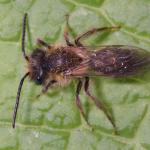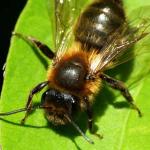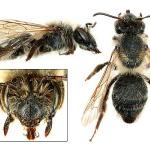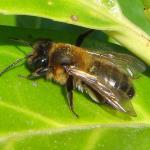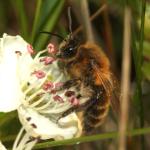Andrena carantonica misident.
Andrena jacobi Perkins, 1921
Andrena johnsoni Perkins, 1921
The map shows combined records for both A. scotia and A. trimmerana as these two species are very difficult to separate and so there exists much doubt about which records apply to which species.
Although usually referred to as scotica in Britain, Schwarz et al. (1996) and Gusenleitner & Schwarz (2002) have treated scotica as a synonym of carantonica Peréz. However, Else & Edwards (in press), following P. Westrich’s (in litt.) interpretation of the type of carantonica, regard this is a separate species, with carantonica a junior synonym of trimmerana. It is one of the larger Andrena species, with a generally dark brown abdomen and a contrasting pattern of dark upper and pale lower hairs on the scopa of the hind leg. This species is one of the later emerging spring bees.
Found over most of the Britain, Ireland and the Channel Islands.
It is widely distributed in Europe.
The map shows combined records for both A. scotia and A. trimmerana as these two species are very difficult to separate and so there exists much doubt about which records apply to which species.
This species is not regarded as scarce or threatened.
Found in a wide range of habitats.
Univoltine; April to June. Adult bees over-winter fully emerged in their natal burrows. Occasionally adults are reported in late September and October. These are most likely to be new adults responding to unusual temperature cues.
May nest singly or communally, frequently in quite concealed locations. Females often share a communal entrance to their burrows. The author has seen something over 200 females entering one area in a 15 minute period at Coates in West Sussex, just before a heavy shower. Interestingly he was not able to repeat this observation in subsequent years. C. Haes reported similar but smaller aggregations under one of the steps in his Cornwall garden, this time regularly over a number of years. L. Hebdon reports similar behaviour in her Lincolnshire garden.
Visits a wide variety of flowers.
Nomada marshamella (Kirby) and N. flava Panzer are cleptoparasites of this species. Both males and females may be frequently stylopised by Stylops aterrimus Newport.
2023


